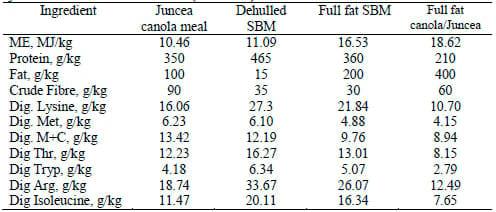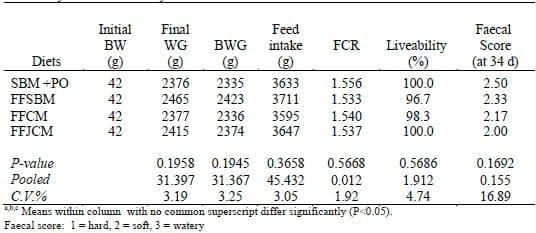I. INTRODUCTION
Juncea canola (Brassica juncea) was developed as a drought and heat tolerant alternative oilseed to canola in Australia. Its oil and meal qualities are similar to canola. The level and types of glucosinolates in the juncea canola meal meet the specification of canola meal with total glusinolates of less 30 umoles/g. (NSW DPI, 2009). Juncea canola oil is low in erucic acid (<2%) and moderate (57-63%) in oleic acid (Pritchard, 2009).
Canola meal (CM) has been used in poultry diets. A previous study using CM at levels higher than 10% in broiler diets showed that growth rate decreased, with poorer feed intake and conversion efficiency (Hickling, 1997). However Perez-Maldonado (2003) found that CM can be used up to 20% during the starter phase and up to 30% during the finisher phase in broiler diets formulated on a digestible amino acid (DAA) basis. This evidence demonstrated that CM can be used as a protein supplement in poultry diets.
Previous work has shown that the metabolisable energy and digestible amino acids of soybean meal were increased by about 10% when using an improved processing method (Creswell & Swick, 2009; Neoh, 2009). The studies reported here were aimed to determine if an improved processing method for juncea CM can increase its protein digestibility/availability and metabolisable energy and to determine if performance of properly processed full fat juncea CM and full fat CM are comparable to soybean meal with added vegetable oils and full fat soybean meal in broiler feeding.
II. METHOD AND MATERIALS
Two broiler trials were conducted at Bangkok Animal Research Center (BARC), Thailand. The first trial examined broiler performance when the high efficiency juncea CM (HEJCM) replaced 5%, 10% and 15% of soybean meal in broiler diets. The second trial compared correctly processed full fat juncea CM (FFJCM) and full fat canola meal (FFCM) with dehulled full fat soybean meal (FFSBM) and dehulled soybean meal with added palm oil (SBMPO). Starter and grower diets in both trials were formulated following the ideal protein concept to satisfy the minimum nutrient requirements of birds as listed in Table 1. The nutrient matrices of the juncea CM, full fat juncea CM, full fat CM, and FFSBM used for these two trials are presented in Table 2.
A total of 240 day old male Arbor Acres Plus broiler chicks were used in each trial. Chicks were assigned to four treatments with six replicates per treatment. Chicks were allocated equally over 24 pens at ten chicks per pen. Chicks were raised on rice hull bedding material over concrete floor pens.
Starter diets were offered to the birds from 0 to 16 days of age and grower diets were offered from 17 to 34 days of age. All diets and water were provided ad libitum throughout the 34 day experimental period. Body weight was determined at 0, 16 and 34 days of age. Total feed consumption was measured at 16 and 34 days of age. Faecal moisture was scored at day 35. Mortality was recorded daily.
Table 1. Minimum nutrients content of the diets (as is basis)
Table 2. Nutrient matrixes of juncea canola meal, dehulled SBM, full fat SBM, full fat juncea canola and full fat canola (as is basis)
III. RESULTS AND DISCUSSION
Broiler performance for Trial 1 is shown in Table 3. There were no differences in body weight gain or feed conversion ratio (FCR) among diets with different inclusion rates of juncea CM.
At day 34, broilers offered the diet with 10% high efficiency juncea CM had the highest feed intake (3745g) which was higher (P<0.05) than those fed 0% juncea CM. Other studies have shown no reduction in feed intake when CM was used up to 15% (Rojas et al., 1985 & Leeson et al., 1987). In all treatments, birds presented similar liveability and faecal score.
Table 3. Performance of high efficiency juncea canola meal in broiler feedings (0-34 days of age).
Trial 2
There were no differences (P<0.05) in body weight gain, feed intake and FCR amongst the diets (Table 4) andthe liveability and faecal score were similar among diets. Numerically, the FFSBM diet had the highest body weight gain and lowest FCR. In general, the diets containing FFSBM, FFCM or FFJCM had numerically lower feed conversion ratios when compared to the diet using SBM with added palm oil. These results showed that juncea CM and CM when processed into full fat meals performed similarly to FFSBM or SBM with added palm oil.
Table 4. Broiler performance (0-34 days) when using full fat juncea canola, canola meal, full fat soybean meal and soybean meal with added oil.
IV. CONCLUSION
Trial 1 suggests that juncea CM can be used in the broiler diets at a level of up to 15% without affecting growth performance. It is interesting to note that despite formulating with a higher metabolizable energy of 10.46MJ/kg for the high efficiency juncea CM and 5% higher digestible amino acid levels than normal CM, the high efficiency juncea CM performed equally to the diet using only SBM.
Trial 2 demonstrates that juncea canola and canola can be processed into full fat meals with high metabilizable energy and digestible amino acids which are 5% higher than normal CM. With an oil content of 40%, these full fat meals can completely replace FFSBM or SBM with added vegetable oil in broiler diets.
REFERENCES
Creswell D, Swick R (2008) Asian Poultry Magazine. April 2009, 10-13.
Pritchard F (2009) Australian Grain Magazine Nov. – Dec. 38-39.
Hameed S, Ahmad N, Rabbani M (2002) International Journal of Agriculture & Biology 4(3), 389- 391.
Hill R (1991) Nutrition Abstracts and Reviews (Series B) 61 (3).
Hickling D (1997) Canola Meal Feed Industry Guide Poultry 14.
Hickling D (2001) Canola meal Feed Industry Guide 3rd edition.
Leeson S, Atteh JO, Summers JD (1987) Poultry Science 66 (5), 875-880.
Montazer-Sadegh R, Ebrahim-Nezhad Y, Maheri-Sis N (2008) Asian Journal of Animal and Veterinary Advances 3(5), 278-285.
Neoh SB (2009) Asian Poultry Magazine September 2009, 20-23.
Naseem MZ (2006) Journal Animal Poultry Industry Science 16, 3-4.
Classen HL, Newkirk RW, Maenz DD (2004) Proceedings Australia Poultry Science Symposium 16, 1-8.
Perez-Maldonado RA (2003) Asia Pacific Journal of Clinical Nutrition 12 Supplement S41.
NSW DPI (2009) Primefact 786 second edition.
Rojas EA, Gonzalez D, Tirado AJ (1985) Nutrition Abstracts and Reviews Series (B) 57, 3765.













.jpg&w=3840&q=75)